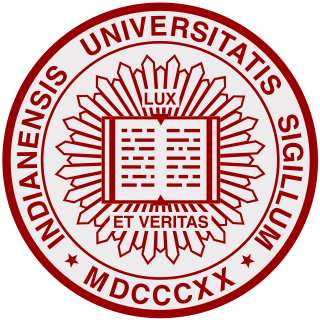
Indiana University Bloomington is a public research university in Bloomington, Indiana. It is the flagship campus of the Indiana University and, with over 40,000 students, its largest campus.
The Kelley School of Business (KSB) is an undergraduate and graduate business school at Indiana University in Bloomington, Indiana and Indianapolis, Indiana, United States. As of 2017, approximately 7,500 full-time undergraduate and graduate students are enrolled on its Bloomington campus, as well as 1,740 students at the Indianapolis campus. In addition, more than 800 students study for graduate degrees through the school's online MBA and MS programs through "Kelley Direct".
The Lunar and Planetary Institute (LPI) is a scientific research institute dedicated to study of the solar system, its formation, evolution, and current state. The Institute is part of the Universities Space Research Association (USRA) and is supported by the Science Mission Directorate of the National Aeronautics and Space Administration (NASA). Located at 3600 Bay Area Boulevard in Houston, Texas, the LPI maintains an extensive collection of lunar and planetary data, carries out education and public outreach programs, and offers meeting coordination and publishing services. The LPI sponsors and organizes several workshops and conferences throughout the year, including the Lunar and Planetary Science Conference (LPSC) held in March in the Houston area.
The Office of the Provost at Indiana University Bloomington oversees the academic programs, research, and policies of 16 schools on the Indiana University Bloomington campus. Together, these units offer more than 550 individual degree programs and majors.
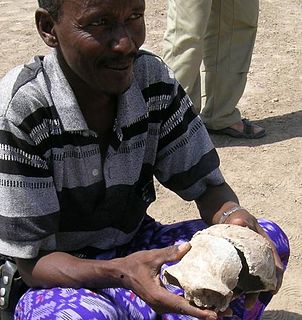
The Gawis cranium is a portion of a fossil hominin skull discovered on February 16, 2006 near the drainage of Gawis, a tributary of the Awash River in the Afar Depression, Ethiopia. Despite the presence of volcanic ash layers that are key to dating, the cranium is only generally dated between 200,000 and 500,000 years ago due to taphonomic issues.
Charles Kimberlin Brain, also known as C. K. 'Bob' Brain, is a South African paleontologist who has studied and taught African cave taphonomy for more than fifty years.
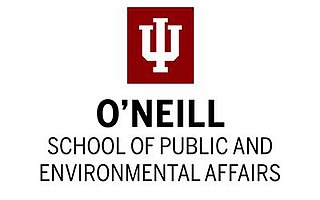
The O'Neill School of Public and Environmental Affairs is one of the undergraduate and graduate schools of Indiana University, and is the largest public policy and environmental studies school of its kind in the United States. Founded in 1972, as the Indiana University School of Public and Environmental Affairs, it was the first school to combine public management, policy, and administration with the environmental sciences. The school was founded on the IU Bloomington campus, and today also has a campus at Indiana University – Purdue University Indianapolis (IUPUI). O'Neill School Bloomington is the top ranked school of public affairs in the United States. The school received a facelift and expansion when the Paul O'Neill Graduate Center opened for classes in the Spring 2017 semester due to the growing influx of students. On March 4, 2019, the name was changed to the O'Neill School of Public and Environmental Affairs, in honor of alumnus Paul H. O'Neill, who served as the United States Secretary of the Treasury in 2001–2002.
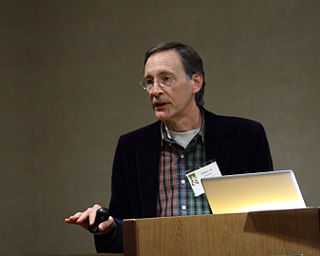
Robert Neel Proctor is an American historian of science and Professor of the History of Science at Stanford University, where he is also Professor by courtesy of Pulmonary Medicine. While a professor of the history of science at Pennsylvania State University in 1999, he became the first historian to testify against the tobacco industry.
William M. Fields, also known by the lexigram , is an American qualitative investigator studying language, culture, and tools in non-human primates. He is best known for his collaboration with Sue Savage-Rumbaugh beginning in 1997 at the Language Research Center of Georgia State University. There he co-reared Nyota , a baby bonobo, with Panbanisha , Kanzi and Savage-Rumbaugh . Fields and Savage-Rumbaugh are the only scientists in the world carrying out language research with bonobos.
Discovery Park is a 40-acre (160,000 m2) multidisciplinary research park located in Purdue University's West Lafayette campus in the U.S. state of Indiana. Tomás Díaz de la Rubia, an energy and resources industry executive who also spent a decade as a top scientist and administrator at Lawrence Livermore National Laboratory, serves as Discovery Park's Vice President.
The Department of Central Eurasian Studies, often abbreviated as CEUS, is a specialized academic department in the School of Global and International Studies at the Bloomington campus of Indiana University, in Bloomington, Indiana. Since its original formation in 1943 as a language-training program for the U.S. military, the department has become the sole independent degree-granting academic unit staffed with its own faculty dedicated to Central Eurasia in the country. Due to the department and the presence of several additional centers - the Inner Asian & Uralic National Resource Center, the Denis Sinor Research Institute for Inner Asian Studies, and the Center for Languages of the Central Asian Region - Indiana University currently hosts the premier program of Central Asian studies in the United States.

Debby Herbenick ) is an American author, research scientist, sex educator, sex advice columnist, children's book author, blogger, television personality, professor, and human sexuality expert in the media. Herbenick is a professor at the Indiana University School of Public Health (IUSPH) and lead investigator of the National Survey of Sexual Health and Behavior (NSSHB), which Time called "the most comprehensive survey of its kind in nearly two decades."
Anna Curtenius Roosevelt is an American archaeologist and Professor of Anthropology at the University of Illinois at Chicago. She studies human evolution and long-term human-environment interaction. She is one of the leading American archeologists studying Paleoindians in the Amazon basin. Her field research has included significant findings at Marajo Island and Caverna da Pedra Pintada in Brazil. She does additional field work in the Congo Basin. She is the great-granddaughter of United States President Theodore Roosevelt.

The WonderLab Museum of Science, Health & Technology is a science museum located in the city of Bloomington, Indiana, United States. It was incorporated in 1995 as a private 501(c)(3) non-profit organization. WonderLab is a member of the Association of Science-Technology Centers.

The College of Arts, Humanities and Social Sciences at the University of Maryland, Baltimore County (CAHSS) has 22 departments, and offers 30 Bachelor's, 16 Master's, and 6 Ph.D. programs. The college also includes several scholarship programs; the Linehan Artist Scholars Program, the Humanities Scholars Program, and the Sondheim Public Affairs Scholars Program. The college oversees several centers; the Dresher Center for Humanities, the Imaging Research Center, and the Maryland Institute for Policy Analysis and Research.

Robert D. Martin is a British-born biological anthropologist who is currently an Emeritus Curator at The Field Museum of Natural History in Chicago, Illinois. He is also an adjunct professor at University of Chicago, Northwestern University, and University of Illinois Chicago. His research spans the fields of anthropology, evolutionary biology and human reproductive biology. Additionally, he writes a blog on human reproduction for Psychology Today.

The Indiana University School of Public Health-Bloomington is an undergraduate and graduate school at Indiana University Bloomington. Until 2012, it was the School of Health, Physical Education, and Recreation (HPER). Now, the School of Public Health on IU's Bloomington campus enrolls 2,790 undergraduate and graduate students, offers 34 different degrees, and has five academic departments. In 2020, the School of Public Health-Bloomington was reaccredited by the Council on Education for Public Health.
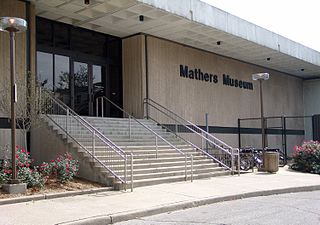
Mathers Museum of World Cultures was a museum of ethnography and cultural history that features exhibitions of traditional and folk arts at Indiana University in Bloomington, Indiana. It also offered practicum studies at the university for graduate and undergraduate students. The museum also worked to promote local artists. Located at 416 North Indiana Avenue, the Museum closed in Spring 2020, and is slated to open as the Indiana University Museum of Archaeology and Anthropology.

Nicholas Patrick Toth is an American archaeologist and paleoanthropologist. He is a Professor in the Cognitive Science Program at Indiana University and is a founder and co-director of the Stone Age Institute. Toth's archaeological and experimental research has focused on the stone tool technology of Early Stone Age hominins who produced Oldowan and Acheulean artifacts which have been discovered across Africa, Asia, the Middle East, and Europe. He is best known for his experimental work, with Kathy Schick, including their work with the bonobo Kanzi who they taught to make and use simple stone tools similar to those made by our Early Stone Age ancestors.
Kathy Diane Schick is an American-born archaeologist. She currently works as an anthropology professor in the Department of Biology and Geological Science at Indiana University, Bloomington. She is also the co-director, executive board members, and Secretary/Treasurer of the Stone Age Institute and CRAFT where she researches alongside her husband, Nicholas Toth, on the archaeological evidence relating to human origins and tools of survival. Through her extensive research and fieldwork, she outlines connections between technology and culture through the study of prehistoric human life and the development of tools crafted by humans in the Stone Age. Her fieldwork covers a wide range of activities from uncovering archaeological sites to conducting experiments across the globe, in laboratories in Africa, Europe, and Asia. In a series of experiments, Schick and Toth trained a bonobo to craft stone tools, using their observations to analyze the mechanics of early stone tool making and the role of evolution in relation to the development of technology such as stone tools. In addition to her research endeavors, she has authored and co-authored numerous articles in various publications. She has also co-founded exhibits showcasing her research including “From the Big Bang to the World Wide Web: The Origins of Everything”, located at Indiana University, Bloomington, and the Stone Age Institute, a repository of archaeological research relating human origins and technology through the development of early tools.












